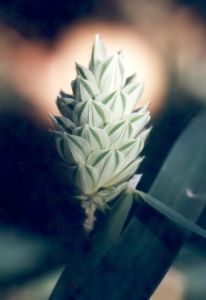Grass
by Valerie (June 13, 2000)
revised August 29, 2003
 There are thousands of kinds of grasses, some more interesting than others. Some species aren't that photogenic, especially when they are mowed down and stepped all over. Of course, all the food grains are important, and so is bamboo, and the sedges, but I'll just cover a few types of ordinary grass here. There are thousands of kinds of grasses, some more interesting than others. Some species aren't that photogenic, especially when they are mowed down and stepped all over. Of course, all the food grains are important, and so is bamboo, and the sedges, but I'll just cover a few types of ordinary grass here.
Grasses are a huge group of monocots. They are fairly recent in evolutionary terms, but are currently one of the most successful types of plants, especially in extreme climates. They excel at colonizing areas where there is too little rain to support trees, freezes are too cold and long for many succulents and other desert plants, and fires are frequent. The Great Plains of the central United States is ideal grassland.
Bermuda grass (Cynodon dactylon), an import, is the second most common turf grass around here. We have a little of it mixed in with the St. Augustine. Bermuda is finer, develops very deep roots and rhizomes, and endures drought well, even if the exposed leaves and stems die. People with solid Bermuda lawns water it a lot in the summer to keep it green. When Bermuda grass blooms, the long, thin inflorescences (stems with flowers) are covered with sticky pollen or stamens (I'm not sure which). Luckily, the sticky substance is water soluble and so washes off easily. Because of the deep growth, it is nearly impossible to eradicate Bermuda grass where it is not wanted. Even one little piece left in the soil will eventually grow back into a complete plant. Thus we have this grass growing in many parts of our gardens.
One kind of grass that is always present, but that I try to keep under control is Johnson grass (Sorghum halepense), pictured above at left. Introduced from the Mediterranean, it's not very good for lawns because it grows several feet tall and is thick and tough. Here in Austin it is one of the most bothersome of the wild grasses and spreads with long underground rhizomes. This grass is a huge, Texas-size version of crab grass.
The wild grasses often don't look like much until they go to seed. The leaves of most species generally look the same and the flowers are very tiny. Grass flowers even have their own terminology because of their diminutive size and are called florets. The foxtail, or green bristlegrass (Setaria viridis), pictured above at right has barely discernible florets. I've never even noticed the flowers of inland sea oats (Chasmanthium latifolium), illustrated at right, just the prominent seeds. Also called wild oats and northern sea oats, this bunchgrass is a popular landscape plant. Some grasses do not bother with complete flowers, but just form the reproductive parts, such as the stamens hanging from the inflorescence shown below at left. It is easy to appreciate the lovely symmetry of many types of grasses, such as the seeds of a common native grass called little barley (Hordeum pusillum), pictured above at left.
My favorite type of grass has always been squirreltail (Hordeum jubatum), with its silky soft seed heads. While it isn't common around here, it does appear once in a while. It is better adapted to cooler climates.
A couple kinds of grass are especially painful. Sand burrs (Cenchrus spinifex) proliferate in this area, as well as spear grass. After taking the dog for a walk, it is always necessary to check her quickly after getting back before the spear grass has a chance to work its way into her skin, and those little seeds seem to travel just as quickly through socks as through her fur. When we first moved into our house, sand burrs were present in the sparse lawn. Their foliage looks just like any other grass but I frequently found the plants by walking barefoot. The burrs are so painful that I was inspired to eradicate the species from our yard, and did so in only a couple of years.
The last picture here is of a type of grass that occasionally grows in our yard and gardens, brought in by birds. It is called canary seed grass or annual canary grass (Phalaris canariensis) and looks a lot like any other grass (and we have plenty of different kinds, especially in the gardens) until it blooms and produces its seed head. Although the leaves aren't variegated, the bracts surrounding the seeds are. This grass grows only a few inches tall and we have to get down on its level to appreciate its beauty. |
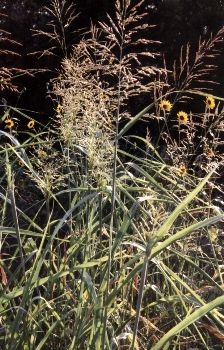 Our lawn has a number of species of grass (along with other plants) and it's mostly a matter of pulling up the unwanted and watering the desired. The most prominent grass in our lawn is St. Augustine (Stenotaphrum secundatum), which is native to coastal areas in the U.S. St. Augustine does not root very deeply, spreading along the ground and often into the gardens. It endures heat very well and can grow adequately in partial shade. The BIG drawback is that it needs supplemental water in our area. It is the most popular turf grass in Austin, even if it takes horrendous amounts of water to survive our summers and sometimes freezes out when we have a lower than normal freeze.
Our lawn has a number of species of grass (along with other plants) and it's mostly a matter of pulling up the unwanted and watering the desired. The most prominent grass in our lawn is St. Augustine (Stenotaphrum secundatum), which is native to coastal areas in the U.S. St. Augustine does not root very deeply, spreading along the ground and often into the gardens. It endures heat very well and can grow adequately in partial shade. The BIG drawback is that it needs supplemental water in our area. It is the most popular turf grass in Austin, even if it takes horrendous amounts of water to survive our summers and sometimes freezes out when we have a lower than normal freeze.
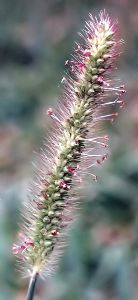
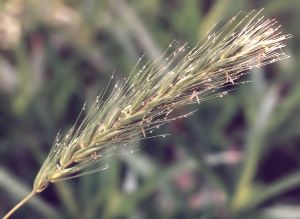
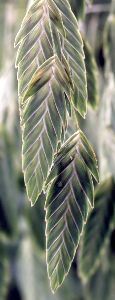
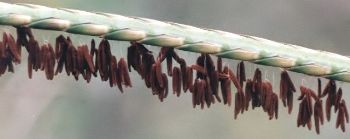 I often admire the seeds of different kinds of grass that grow along the roads: bushy, long and flowing, silky, or even colorful. Some seeds are in clusters and others seem to float individually on thin wiry stems. Small stands or huge fields, the grasses are definite eye-catchers.
I often admire the seeds of different kinds of grass that grow along the roads: bushy, long and flowing, silky, or even colorful. Some seeds are in clusters and others seem to float individually on thin wiry stems. Small stands or huge fields, the grasses are definite eye-catchers.

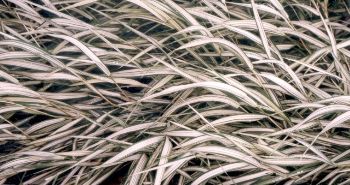 There are exceptions to the dull leaves of grass: the variegated varieties. The stripes of some grasses make a fascinating pattern.
There are exceptions to the dull leaves of grass: the variegated varieties. The stripes of some grasses make a fascinating pattern.
